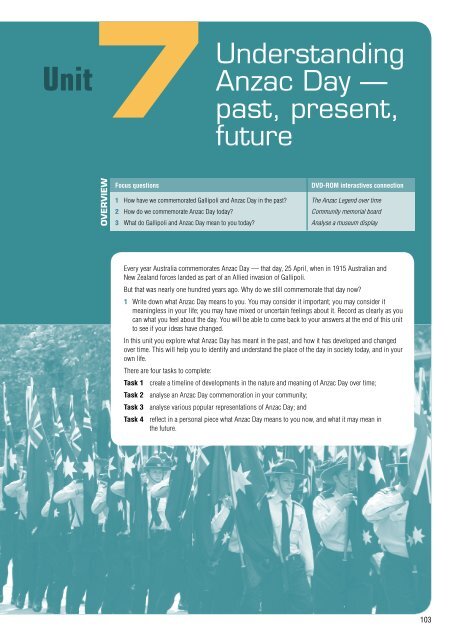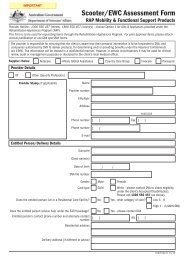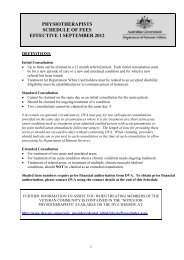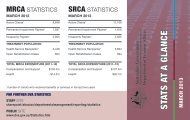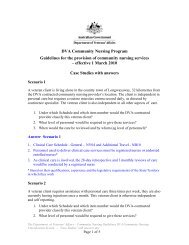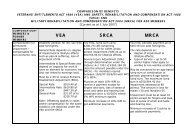Gallipoli and the Anzacs - Unit 7 - Understanding Anzac Day — past ...
Gallipoli and the Anzacs - Unit 7 - Understanding Anzac Day — past ...
Gallipoli and the Anzacs - Unit 7 - Understanding Anzac Day — past ...
Create successful ePaper yourself
Turn your PDF publications into a flip-book with our unique Google optimized e-Paper software.
<strong>Unit</strong><br />
Overview<br />
Underst<strong>and</strong>ing<br />
<strong>Anzac</strong> <strong>Day</strong> <strong>—</strong><br />
<strong>past</strong>, present,<br />
future<br />
Focus questions DVD-ROM interactives connection<br />
1 How have we commemorated <strong>Gallipoli</strong> <strong>and</strong> <strong>Anzac</strong> <strong>Day</strong> in <strong>the</strong> <strong>past</strong>?<br />
2 How do we commemorate <strong>Anzac</strong> <strong>Day</strong> today?<br />
3 What do <strong>Gallipoli</strong> <strong>and</strong> <strong>Anzac</strong> <strong>Day</strong> mean to you today?<br />
The <strong>Anzac</strong> Legend over time<br />
Community memorial board<br />
Analyse a museum display<br />
Every year Australia commemorates <strong>Anzac</strong> <strong>Day</strong> <strong>—</strong> that day, 25 April, when in 1915 Australian <strong>and</strong><br />
New Zeal<strong>and</strong> forces l<strong>and</strong>ed as part of an Allied invasion of <strong>Gallipoli</strong>.<br />
But that was nearly one hundred years ago. Why do we still commemorate that day now?<br />
1 Write down what <strong>Anzac</strong> <strong>Day</strong> means to you. You may consider it important; you may consider it<br />
meaningless in your life; you may have mixed or uncertain feelings about it. Record as clearly as you<br />
can what you feel about <strong>the</strong> day. You will be able to come back to your answers at <strong>the</strong> end of this unit<br />
to see if your ideas have changed.<br />
In this unit you explore what <strong>Anzac</strong> <strong>Day</strong> has meant in <strong>the</strong> <strong>past</strong>, <strong>and</strong> how it has developed <strong>and</strong> changed<br />
over time. This will help you to identify <strong>and</strong> underst<strong>and</strong> <strong>the</strong> place of <strong>the</strong> day in society today, <strong>and</strong> in your<br />
own life.<br />
There are four tasks to complete:<br />
Task 1 create a timeline of developments in <strong>the</strong> nature <strong>and</strong> meaning of <strong>Anzac</strong> <strong>Day</strong> over time;<br />
Task 2 analyse an <strong>Anzac</strong> <strong>Day</strong> commemoration in your community;<br />
Task 3 analyse various popular representations of <strong>Anzac</strong> <strong>Day</strong>; <strong>and</strong><br />
Task 4 reflect in a personal piece what <strong>Anzac</strong> <strong>Day</strong> means to you now, <strong>and</strong> what it may mean in<br />
<strong>the</strong> future.<br />
103
Task 1 Create a timeline<br />
<strong>Anzac</strong> <strong>Day</strong> is <strong>the</strong> anniversary of <strong>the</strong> l<strong>and</strong>ing of <strong>the</strong> <strong><strong>Anzac</strong>s</strong> as part of<br />
an Allied force at <strong>Gallipoli</strong> in 1915.<br />
How has <strong>Anzac</strong> <strong>Day</strong> developed over time?<br />
Look at <strong>the</strong> following collection of information, evidence <strong>and</strong><br />
opinion on pages 105–112.<br />
Your task is to read <strong>the</strong> material, decide where on <strong>the</strong> timeline<br />
it best fits, <strong>and</strong> what it tells you about how Australians perceive<br />
<strong>Anzac</strong> <strong>Day</strong>. For example, you may decide that <strong>the</strong> publication of <strong>the</strong><br />
play The One <strong>Day</strong> of <strong>the</strong> Year in 1960 showed a decline in respect<br />
for <strong>Anzac</strong> <strong>Day</strong>, whereas <strong>the</strong> release of Peter Weir’s popular film<br />
<strong>Gallipoli</strong> in 1981 shows that <strong>the</strong>re was increasing interest in <strong>the</strong><br />
104<br />
<strong>Unit</strong> 7<br />
Focus question<br />
A timeline of <strong>Anzac</strong> <strong>Day</strong> commemoration<br />
How have we<br />
commemorated<br />
<strong>Gallipoli</strong> <strong>and</strong> <strong>Anzac</strong> <strong>Day</strong><br />
in <strong>the</strong> <strong>past</strong>?<br />
story of <strong>Gallipoli</strong> <strong>and</strong> its relevance to Australians’ sense of national<br />
identity. You should enter <strong>the</strong>se key events <strong>and</strong> your commentary<br />
on <strong>the</strong>m in <strong>the</strong> relevant decade.<br />
Divide <strong>the</strong> following Resource pages among groups in your<br />
class. Each group is responsible for summarising one or two of<br />
<strong>the</strong> Resource pages <strong>and</strong> reporting back to <strong>the</strong> whole class. In that<br />
way every member of <strong>the</strong> class will be able to gain information <strong>and</strong><br />
insight from all <strong>the</strong> evidence, without having to work through it all<br />
in detail.<br />
An alternative approach to this activity is on <strong>the</strong> DVD-ROM<br />
included with this resource, The <strong>Anzac</strong> legend over time.<br />
Period Source What it tells you about <strong>the</strong> Australian perception of <strong>Anzac</strong> <strong>Day</strong> in this period<br />
1915 –1919<br />
1920s<br />
1930s<br />
1940s<br />
1950s<br />
1960s<br />
1970s<br />
1980s<br />
1990s<br />
2000s
Resource Page 1<br />
For each of <strong>the</strong>se sources identify:<br />
1 What period of <strong>the</strong> timeline it fits.<br />
2 What it tells you about <strong>the</strong> way <strong>Gallipoli</strong> <strong>and</strong> <strong>Anzac</strong> <strong>Day</strong> were regarded at this time.<br />
Source 1 South Australian Governor Sir Henry Galway,<br />
2 July 1915<br />
If any day is to be chosen for Australia’s day I think it should<br />
be April 25 … Those heroes will h<strong>and</strong> down <strong>the</strong> finest<br />
traditions to <strong>the</strong>ir sons <strong>and</strong> <strong>the</strong>ir sons’ sons, <strong>and</strong> still fur<strong>the</strong>r<br />
on … today we not only honour <strong>the</strong> dead, but our hearts go<br />
out with <strong>the</strong> deepest respect <strong>and</strong> sympathy to those who are<br />
mourning <strong>the</strong> loss of <strong>the</strong>ir nearest <strong>and</strong> dearest. The British<br />
Empire will never be able to repay <strong>the</strong> debt owed to <strong>the</strong> women<br />
for <strong>the</strong>ir calm self-sacrifice in this great struggle.’<br />
JG Pavils, <strong>Anzac</strong> <strong>Day</strong>: The Undying Debt, Lythrum Press, Adelaide, 2007, page 5<br />
Source 2 A cartoon comment 1984<br />
Sydney Morning Herald 15 December 1984<br />
Source 3 The Last First World War <strong><strong>Anzac</strong>s</strong><br />
In <strong>the</strong> last decade <strong>the</strong>re was great publicity <strong>and</strong> great respect shown<br />
towards <strong>the</strong> last of <strong>the</strong> Australian First World War veterans who died:<br />
• 2002 <strong>—</strong> Alec Campbell, <strong>the</strong> last Australian <strong>Gallipoli</strong> veteran,<br />
• 2005 <strong>—</strong> William Evan Allen, <strong>the</strong> last Australian to see active<br />
service in First World War (in <strong>the</strong> navy),<br />
• 2009 <strong>—</strong> Jack Ross, <strong>the</strong> last Australian to be in <strong>the</strong> services<br />
during <strong>the</strong> First World War, although he did not see active service.<br />
See The Australian 4 June 2009 (Ross), The Age 18 October 2005 (Allen),<br />
ABC 7.30 Report 16 May 2002 (Campbell)<br />
Source 4 Protection of <strong>the</strong> word ‘<strong>Anzac</strong>’<br />
Commonwealth laws were passed in 1921 to protect <strong>the</strong> word ‘<strong>Anzac</strong>’, <strong>and</strong><br />
any word which resembles it, from inappropriate use. Under <strong>the</strong> Regulations<br />
no person may use <strong>the</strong> word ‘<strong>Anzac</strong>’, or any word resembling it, in connection<br />
with ‘… any trade, business, calling or profession or in connexion with any<br />
entertainment or any lottery or art union or as <strong>the</strong> name or part of a name of<br />
any private residence, boat, vehicle of charitable or o<strong>the</strong>r institution, or o<strong>the</strong>r<br />
institution, or any building …’<br />
www.dva.gov.au/commems_oawg/commemorations/protection_of_<strong>Anzac</strong>/Pages/index.aspx<br />
Source 5 Pilgrimages to <strong>Gallipoli</strong><br />
During <strong>the</strong> 1980s, 1990s <strong>and</strong> into <strong>the</strong> 2000s <strong>the</strong>re has been a huge increase<br />
in <strong>the</strong> numbers of young ‘pilgrims’, men <strong>and</strong> women, ga<strong>the</strong>ring at <strong>Anzac</strong> Cove<br />
in Turkey for <strong>the</strong> <strong>Anzac</strong> <strong>Day</strong> ceremony. Even though only 8000 of <strong>the</strong> 60,000<br />
Australians who died in <strong>the</strong> First World War died <strong>the</strong>re, <strong>Gallipoli</strong> has a much<br />
stronger place in <strong>the</strong> Australian consciousness than <strong>the</strong> Western Front.<br />
In his book Return to <strong>Gallipoli</strong> Historian Bruce Scates has analysed <strong>the</strong><br />
reasons why young people came to <strong>Gallipoli</strong> for <strong>Anzac</strong> <strong>Day</strong>. He believes that<br />
for a few it is a connection with old family stories, for some it is a compulsory<br />
place on <strong>the</strong> international backpacker itinerary, for many it is a celebration of<br />
identity, part of a search to experience ‘being Australian’. For whatever reason<br />
young people were <strong>the</strong>re, one of <strong>the</strong> most powerful outcomes is that for <strong>the</strong>se<br />
young people history gained faces <strong>and</strong> names, gained reality, <strong>and</strong> that gave<br />
<strong>Anzac</strong> <strong>Day</strong> great power in <strong>the</strong>ir minds.<br />
Bruce Scates, Return to <strong>Gallipoli</strong>, Cambridge University Press, New York, 2006, passim<br />
Source 6 <strong>Anzac</strong> <strong>Day</strong> marches 1916<br />
In 1916 Australian troops in France, Egypt <strong>and</strong> Britain held services<br />
commemorating <strong>the</strong> l<strong>and</strong>ing, with over 2000 Australian troops marching<br />
along Whitehall to Westminster Abbey in London. The service included<br />
King George V, Australian Prime Minister Billy Hughes, <strong>and</strong> British <strong>and</strong><br />
Australian military leaders.<br />
www.awm.gov.au/commemoration/anzac.anzac_traditions.asp<br />
<strong>Unit</strong><br />
105
For each of <strong>the</strong>se sources identify:<br />
1 What period of <strong>the</strong> timeline it fits.<br />
2 What it tells you about <strong>the</strong> way <strong>Gallipoli</strong> <strong>and</strong> <strong>Anzac</strong> <strong>Day</strong> were regarded at this time.<br />
106<br />
<strong>Unit</strong><br />
Source 7 Australia Remembers 1995<br />
In 1995, we honoured our veterans through Australia<br />
Remembers 1945-1995 <strong>—</strong> a pageant of events commemorating<br />
<strong>the</strong> end of Second World War.<br />
All Australians were given an opportunity to remember those<br />
who served in <strong>the</strong> armed forces, those who died <strong>and</strong> those<br />
who worked so hard at home to fuel <strong>the</strong> war effort. Australia<br />
Remembers celebrated <strong>the</strong> heroism <strong>and</strong> sacrifice of Australian<br />
servicemen <strong>and</strong> women in <strong>the</strong>ir battle for peace.<br />
A total of $9 million was allocated for commemorative events in<br />
cities, suburbs <strong>and</strong> country towns across Australia.<br />
The Prime Minister, The Hon Paul Keating MP said at <strong>the</strong> launch<br />
of <strong>the</strong> program:<br />
‘The generation we will commemorate <strong>and</strong> thank was a heroic<br />
one. Our freedom was <strong>the</strong>ir legacy: <strong>the</strong> robust democracy we<br />
enjoy, <strong>the</strong> security, <strong>the</strong> marvellous continent which is ours, <strong>the</strong><br />
unequalled personal freedoms.<br />
But <strong>the</strong>y left us more than that. They passed on a tradition <strong>and</strong> a<br />
faith for us to live by. By <strong>the</strong>ir example <strong>the</strong>y taught us about <strong>the</strong><br />
ties that bind us, <strong>and</strong> our common cause.<br />
And by <strong>the</strong> same example <strong>the</strong>y compel us now, not just to<br />
remember <strong>the</strong>m, but to pass on <strong>the</strong> lesson to our children.’<br />
The Australia Remembers 50th Anniversary Commemorative<br />
activities, to celebrate <strong>the</strong> end of <strong>the</strong> Second World War in <strong>the</strong><br />
Pacific, provided <strong>the</strong> Australian people with <strong>the</strong> opportunity to<br />
learn about <strong>the</strong> history of <strong>the</strong>ir country <strong>and</strong> <strong>the</strong> impact that <strong>the</strong><br />
war had upon Australia <strong>and</strong> South East Asia.<br />
www.diggerhistory.info/pages-conflicts-periods/ww2/aus-remembers.htm<br />
Source 8 Memoriam Notice 1923<br />
FOTHERGILL In loving memory of our darling son <strong>and</strong> bro<strong>the</strong>r<br />
(Jack) who was killed in action in <strong>Gallipoli</strong>, 25th April 1915.<br />
Eight long years since you were laid in your lonely grave,<br />
darling Jack. The world has never been <strong>the</strong> same. No one knows<br />
how much I miss you, plucked like a flower in bloom, so bright,<br />
so young, so loving. It’s sad but true, <strong>the</strong> best are <strong>the</strong> first to<br />
die. Darling Jack, if only I could see your grave, I would die<br />
happy (inserted by your sorrowing parents, bro<strong>the</strong>r <strong>and</strong> sisters,<br />
R & I Fo<strong>the</strong>rgill).<br />
The Argus (Melbourne) 25 April 1923<br />
Focus<br />
question<br />
How have we commemorated <strong>Gallipoli</strong><br />
<strong>and</strong> <strong>Anzac</strong> <strong>Day</strong> in <strong>the</strong> <strong>past</strong>?<br />
Resource Page 2<br />
Source 9 Extract from a Victorian Primary School Reader,<br />
1932<br />
ANZAC DAY<br />
1 The boys <strong>and</strong> girls of to-day live in a time of peace. There is<br />
no great war to call <strong>the</strong>ir fa<strong>the</strong>rs <strong>and</strong> bro<strong>the</strong>rs far across <strong>the</strong><br />
seas. Are you not glad?<br />
2 It was not always so. Years ago many of our finest men sailed<br />
far away to take part in <strong>the</strong> greatest war <strong>the</strong> world has ever<br />
known.<br />
3 They did not go because <strong>the</strong>y like fighting o<strong>the</strong>r men, it was<br />
not easy for <strong>the</strong>m to leave Australia, <strong>and</strong> it was not easy for<br />
<strong>the</strong>ir own fold to let <strong>the</strong>m go. They went because <strong>the</strong>y thought<br />
it was <strong>the</strong>ir duty to go.<br />
4 In those days <strong>the</strong> British Empire was at war with Germany<br />
<strong>and</strong> Turkey. Our men were sent to l<strong>and</strong> on a peninsula called<br />
<strong>Gallipoli</strong>, on <strong>the</strong> shores of Turkey.<br />
5 They were taken <strong>the</strong>re in ships <strong>and</strong> just before <strong>the</strong> dawn on<br />
<strong>the</strong> 25th April, 1915, <strong>the</strong>y climbed over <strong>the</strong> ships’ sides into<br />
little boats. These little boats were towed towards <strong>the</strong> shore<br />
by launches.<br />
6 It was a terrible time. The Turks were waiting for our men on<br />
<strong>the</strong> beach. Great guns began to fire, <strong>and</strong> bullets hit <strong>the</strong> boats,<br />
many of our men were killed <strong>and</strong> wounded before <strong>the</strong> boats<br />
reached <strong>the</strong> shores.<br />
7 Yet, in spite of all, those who were untouched sprang ashore,<br />
<strong>and</strong> fought <strong>the</strong>ir way up <strong>the</strong> cliffs. They won a strip of l<strong>and</strong>,<br />
which was held by <strong>the</strong>m for eight months. It was called <strong>Anzac</strong><br />
Cove. This name was formed from <strong>the</strong> first letters of <strong>the</strong><br />
words, Australian <strong>and</strong> New Zeal<strong>and</strong> Army Corps.<br />
8 So, on every <strong>Anzac</strong> <strong>Day</strong>, we remember <strong>the</strong> men who made<br />
that l<strong>and</strong>ing. Some of <strong>the</strong>m are still living amongst us, but<br />
many of <strong>the</strong>m lie in graves in far <strong>Gallipoli</strong>. They were all<br />
brave men.<br />
9 They died that we might live in peace. Surely, <strong>the</strong>n, we must<br />
work to keep peace among <strong>the</strong> nations.<br />
Victorian School Paper, 1932
Resource Page 3<br />
For each of <strong>the</strong>se sources identify:<br />
1 What period of <strong>the</strong> timeline it fits.<br />
2 What it tells you about <strong>the</strong> way <strong>Gallipoli</strong> <strong>and</strong> <strong>Anzac</strong> <strong>Day</strong> were regarded at this time.<br />
Source 10 A comparison of three <strong>Anzac</strong> <strong>Day</strong>s<br />
A film comparison of three ceremonies suggests <strong>the</strong>se changes:<br />
• The unveiling of a war memorial in Sydney in 1916 shows mainly women in black for mourning<br />
• The 1926 <strong>Anzac</strong> <strong>Day</strong> march in Melbourne shows women laying wreaths, returned men marching, <strong>and</strong> crippled<br />
<strong>and</strong> wounded men in carriages <strong>and</strong> cars<br />
• The 1930s Sydney <strong>Anzac</strong> <strong>Day</strong>s show men marching, <strong>and</strong> only a few elderly women laying wreaths.<br />
Tanja Luckins, The Gates of Memory. Australian People’s Experiences <strong>and</strong> Memories of Loss <strong>and</strong> <strong>the</strong> Great War, Curtin University Books, Fremantle, 2004, page 199<br />
Source 11 The One <strong>Day</strong> of <strong>the</strong> Year<br />
The One <strong>Day</strong> of <strong>the</strong> Year, was first performed by an amateur<br />
organisation, <strong>the</strong> Adelaide Theatre Group. The play had been<br />
rejected by <strong>the</strong> Adelaide Festival’s Board of Governors on <strong>the</strong> basis<br />
that it might cause offence to former armed forces personnel for<br />
its treatment of <strong>Anzac</strong> <strong>Day</strong> commemorations. In 1961 <strong>the</strong> play was<br />
performed professionally with great success in Sydney with <strong>the</strong><br />
support of <strong>the</strong> Australian Elizabethan Theatre Trust. It was also<br />
performed in London … A play which contains <strong>the</strong> once-heretical<br />
perspective that <strong>Anzac</strong> <strong>Day</strong> – <strong>the</strong> proud emblem of Australia’s military<br />
sacrifice – was founded on confused ideals <strong>and</strong> often degenerated<br />
into a squalid orgy of drunkenness <strong>and</strong> street brawls … The One<br />
<strong>Day</strong> of <strong>the</strong> Year was inspired by an article in <strong>the</strong> University of<br />
Sydney newspaper Honi Soit lambasting <strong>Anzac</strong> <strong>Day</strong>. The article,<br />
says Seymour, was considerably more strident than <strong>the</strong> photo essay<br />
about drunken diggers concocted by <strong>the</strong> play’s young characters:<br />
a university student, Hughie Cook, <strong>and</strong> his North Shore girlfriend<br />
Jan Castle. Seymour saw <strong>the</strong> Honi Soit article as an emblem of<br />
a generational shift, <strong>the</strong> chasm between an older Australia that<br />
venerated <strong>the</strong> <strong><strong>Anzac</strong>s</strong> <strong>and</strong> a younger voice disgusted by war <strong>and</strong> ready<br />
to question <strong>the</strong> <strong>past</strong>. His own impressions of <strong>the</strong> commemoration<br />
were shaped in <strong>the</strong> 1950s when he ventured into Sydney on an<br />
<strong>Anzac</strong> <strong>Day</strong> morning from his home in <strong>the</strong> city’s inner-west. He<br />
returned to a frightening scene – drunken men brawling <strong>and</strong> vomiting<br />
in <strong>the</strong> street.<br />
<strong>Unit</strong><br />
This alcohol-fuelled debasement is represented in <strong>the</strong> play by <strong>the</strong><br />
working-class fa<strong>the</strong>r Alf Cook. Belligerent <strong>and</strong> resentful of foreigners<br />
<strong>and</strong> anyone with an education, Alf clings to <strong>Anzac</strong> <strong>Day</strong> like a<br />
drowning sailor clings to a life raft. Boozing is just part of a noble<br />
tradition.<br />
“I’m a bloody Australian, mate, <strong>and</strong> it’s because I’m a bloody<br />
Australian that I’m gettin’ on <strong>the</strong> grog. It’s <strong>Anzac</strong> <strong>Day</strong> this week, that’s<br />
my day, that’s <strong>the</strong> old digger’s day.”<br />
Seymour, who was born in Fremantle, says Alf’s salty language <strong>and</strong><br />
prejudices were inspired by his late bro<strong>the</strong>r-in-law Alfred Chester<br />
Cru<strong>the</strong>rs. It was Cru<strong>the</strong>rs <strong>and</strong> Seymour’s sister, May, who raised<br />
<strong>the</strong> playwright from <strong>the</strong> age of nine after his fa<strong>the</strong>r was killed in an<br />
accident on Fremantle’s wharves.<br />
“He [Cru<strong>the</strong>rs] had all <strong>the</strong> same qualities,” says Seymour. “He<br />
resented his lack of education <strong>and</strong> he was quite nasty about anyone<br />
that had a better deal than him.” Years later, Cru<strong>the</strong>rs wrote to<br />
Seymour after seeing The One <strong>Day</strong> of <strong>the</strong> Year <strong>and</strong> asked him if Alf<br />
was indeed based on himself. The playwright was unable to reply.<br />
The play’s perspective on <strong>Anzac</strong> <strong>Day</strong> earned it instant notoriety when<br />
it was unleashed on conservative, Menzies-era Australia. On <strong>the</strong> first<br />
night of <strong>the</strong> 1960 Adelaide production a policeman was stationed at<br />
<strong>the</strong> stage door. In 1961, at <strong>the</strong> first professional season in Sydney, a<br />
bomb scare during a dress rehearsal forced police to clear <strong>the</strong> <strong>the</strong>atre.<br />
www.smh.com.au/articles/2003/04/01/1048962752382.html<br />
107
108<br />
<strong>Unit</strong><br />
Source 12 The impact of <strong>the</strong> Vietnam War<br />
Between 1965 <strong>and</strong> 1972 Australian troops, including<br />
conscripts, were sent to fight in Vietnam. Five hundred<br />
<strong>and</strong> twenty-one of <strong>the</strong>m died during <strong>the</strong>ir service. Some<br />
people in Australia were against this involvement, <strong>and</strong><br />
<strong>the</strong>re were some large <strong>and</strong> violent protests. On <strong>the</strong>ir return<br />
some soldiers felt that <strong>the</strong>ir efforts were not appreciated<br />
by <strong>the</strong> Australian people, <strong>and</strong> <strong>the</strong>y felt that <strong>the</strong>y were not<br />
being included as part of <strong>the</strong> <strong>Anzac</strong> tradition. A number<br />
of veterans continued to suffer <strong>the</strong> physical <strong>and</strong> mental<br />
effects of <strong>the</strong>ir service. Some Vietnam veterans chose not<br />
to march in <strong>Anzac</strong> <strong>Day</strong> ceremonies in <strong>the</strong> years following<br />
<strong>the</strong>ir service.<br />
DVA Australia <strong>and</strong> <strong>the</strong> Vietnam War 2007<br />
www.dva.gov.au/commems_oawg/commemorations/education/Documents/<br />
Aus_<strong>and</strong>_<strong>the</strong>_Vietnam_war.pdf<br />
Source 13 Peter Weir’s <strong>Gallipoli</strong><br />
<strong>Gallipoli</strong> is a 1981 Australian film, directed by Peter Weir <strong>and</strong><br />
starring Mel Gibson <strong>and</strong> Mark Lee, about several young men<br />
from rural Western Australia who enlist in <strong>the</strong> Australian Army<br />
during <strong>the</strong> First World War. They are sent to Turkey, where <strong>the</strong>y<br />
take part in <strong>the</strong> <strong>Gallipoli</strong> Campaign. During <strong>the</strong> course of <strong>the</strong><br />
movie, <strong>the</strong> young men slowly lose <strong>the</strong>ir innocence about <strong>the</strong><br />
purpose of war. The climax of <strong>the</strong> movie occurs on <strong>the</strong> <strong>Anzac</strong><br />
battlefield at <strong>Gallipoli</strong> <strong>and</strong> depicts <strong>the</strong> futile attack at <strong>the</strong> Battle of<br />
The Nek on 7 August 1915.<br />
<strong>Gallipoli</strong> provides a faithful portrayal of life in Australia in<br />
<strong>the</strong> 1910s … <strong>and</strong> captures <strong>the</strong> ideals <strong>and</strong> character of <strong>the</strong><br />
Australians who joined up to fight, <strong>and</strong> <strong>the</strong> conditions <strong>the</strong>y<br />
endured on <strong>the</strong> battlefield. It does, however, modify events<br />
for dramatic purposes <strong>and</strong> contains a number of significant<br />
historical inaccuracies. In particular <strong>the</strong> officers responsible for<br />
Entente replace with ‘Allied’ comm<strong>and</strong> of <strong>the</strong> attack are depicted<br />
in <strong>the</strong> film as being British, when in fact most British historians<br />
agree that <strong>the</strong> blame for <strong>the</strong> failure falls at <strong>the</strong> feet of <strong>the</strong> two<br />
Australian Comm<strong>and</strong>ing Officers.<br />
It followed <strong>the</strong> Australian New Wave war film Breaker Morant<br />
(1980) <strong>and</strong> preceded <strong>the</strong> 5-part TV series ANZACs (1985), <strong>and</strong><br />
The Lighthorsemen (1987). Recurring <strong>the</strong>mes of <strong>the</strong>se films<br />
include <strong>the</strong> Australian identity, such as mateship <strong>and</strong> larrikinism,<br />
<strong>the</strong> loss of innocence in war, <strong>and</strong> also <strong>the</strong> continued coming<br />
of age of <strong>the</strong> Australian nation <strong>and</strong> its soldiers (later called <strong>the</strong><br />
ANZAC spirit).<br />
http://en.wikipedia.org/wiki/<strong>Gallipoli</strong>_(1981_film)<br />
Focus<br />
question<br />
For each of <strong>the</strong>se sources identify:<br />
1 What period of <strong>the</strong> timeline it fits.<br />
2 What it tells you about <strong>the</strong> way <strong>Gallipoli</strong> <strong>and</strong> <strong>Anzac</strong> <strong>Day</strong> were regarded at this time.<br />
How have we commemorated <strong>Gallipoli</strong><br />
<strong>and</strong> <strong>Anzac</strong> <strong>Day</strong> in <strong>the</strong> <strong>past</strong>?<br />
Resource Page 4<br />
Source 14 Eric Bogle’s And <strong>the</strong> B<strong>and</strong> Played Waltzing Matilda 1971<br />
This popular folk song about an Australian who fought <strong>and</strong> was badly<br />
wounded at <strong>Gallipoli</strong>, losing his legs, included <strong>the</strong> final verse:<br />
And so now every April, I sit on me porch<br />
And I watch <strong>the</strong> parades pass before me<br />
And I see my old comrades, how proudly <strong>the</strong>y march,<br />
Reviving old dreams of <strong>past</strong> glories<br />
And <strong>the</strong> old men march slowly, old bones stiff <strong>and</strong> sore<br />
They’re tired old heroes from a forgotten war<br />
And <strong>the</strong> young people ask ‘What are <strong>the</strong>y marching for?’<br />
And I ask myself <strong>the</strong> same question<br />
But <strong>the</strong> b<strong>and</strong> plays Waltzing Matilda, <strong>and</strong> <strong>the</strong> old men still answer <strong>the</strong> call<br />
But as year follows year, more old men disappear.<br />
Someday no one will march <strong>the</strong>re at all.<br />
And <strong>the</strong> B<strong>and</strong> Played Waltzing Matilda<br />
Words <strong>and</strong> music by Eric Bogle<br />
© Larrikin Music Publishing Pty Ltd<br />
All rights reserved. International copyright secured.<br />
Reproduced with permission.<br />
Source 15 Some anniversary ‘in memoriam’ notices 1916<br />
CLARK In loving memory of our Jack (Pte John Wasford Clark)<br />
who laid down his life at Gaba Tepe on 25th April 1915 (inserted<br />
by his mo<strong>the</strong>r).<br />
CROWL In loving memory of my dear friend Claud who was<br />
killed on <strong>Gallipoli</strong> on 25th April 1915.<br />
EHRENBERG In loving memory of our dear cousin Morris<br />
(Sgt S.M. Ehrenberg) who was killed in action at <strong>Gallipoli</strong>.<br />
Deeply missed by Doris <strong>and</strong> Eric.<br />
FOTHERGILL In sad memory of our dear son Jack who was last<br />
seen on 25th April 1915 at <strong>the</strong> Dardanelles:<br />
“Far <strong>and</strong> oft our thoughts do w<strong>and</strong>er<br />
To a grave so far away<br />
Where our boy gave his life, so noble <strong>and</strong> brave.<br />
The dear face we love to see.<br />
And in <strong>the</strong> hearts of those that love it,<br />
Ever dear shall be”<br />
Melbourne Argus 25 April 1916
Resource Page 5<br />
For each of <strong>the</strong>se sources identify:<br />
1 What period of <strong>the</strong> timeline it fits.<br />
2 What it tells you about <strong>the</strong> way <strong>Gallipoli</strong> <strong>and</strong> <strong>Anzac</strong> <strong>Day</strong> were regarded at this time.<br />
Source 16 Some Vietnam veterans<br />
comment on <strong>the</strong> significance of <strong>the</strong><br />
Welcome Home parade 1987<br />
On 3 October 1987, 25 000 Australian ex-servicemen<br />
<strong>and</strong> women who had served in Vietnam ga<strong>the</strong>red<br />
in <strong>the</strong> Sydney Domain. They set off behind 500<br />
Australian flags – each one representing one of<br />
<strong>the</strong> Australian dead in <strong>the</strong> Vietnam War. They were<br />
cheered by <strong>the</strong> huge crowd. Many of <strong>the</strong>m wept at<br />
<strong>the</strong> reception <strong>and</strong> recognition <strong>the</strong>y received.<br />
We met mates again, we were welcomed by <strong>the</strong><br />
Australian people, we no longer had to feel almost<br />
unclean about what we had done <strong>and</strong> where we had<br />
been. At last Australia was recognising those men<br />
<strong>and</strong> women it had shunned for so many years. Call it<br />
an emotional healing. Call it a Welcome Home. The<br />
fact is that many of us are now able to st<strong>and</strong> up <strong>and</strong><br />
say with pride ‘I’m a Vietnam veteran’. And people<br />
are listening.<br />
Noel Giblett, Homecomings, Australian Government Publishing Service,<br />
Canberra, 1990<br />
Source 17 A changing focus of <strong>Anzac</strong> <strong>Day</strong><br />
During <strong>the</strong> 1930s <strong>the</strong> focus of <strong>Anzac</strong> <strong>Day</strong> shifted<br />
from a day of mourning to a day on which<br />
servicemen celebrated <strong>the</strong>ir own war service <strong>and</strong><br />
sacrifices. This was an era in which <strong>the</strong> Returned<br />
<strong>and</strong> Services League (RSL) called for greater<br />
acknowledgement of <strong>the</strong> living returned servicemen.<br />
Marina Larsson, Shattered <strong><strong>Anzac</strong>s</strong>. Living with <strong>the</strong> scars of war,<br />
UNSW Press, Sydney, 2009 page 248<br />
Source 18 An <strong>Anzac</strong> <strong>Day</strong> protest 1984<br />
Source 19<br />
A cartoon comment<br />
on <strong>Gallipoli</strong> 1915<br />
<strong>Unit</strong><br />
Ken Inglis, Sacred Places, Melbourne University Press, Melbourne, 2008, page 441<br />
‘Well dad?”<br />
The Bulletin 13 May 1915<br />
109
For each of <strong>the</strong>se sources identify:<br />
1 What period of <strong>the</strong> timeline it fits.<br />
2 What it tells you about <strong>the</strong> way <strong>Gallipoli</strong> <strong>and</strong> <strong>Anzac</strong> <strong>Day</strong> were regarded at this time.<br />
110<br />
<strong>Unit</strong><br />
Source 20 75th Anniversary of <strong>Gallipoli</strong> 1990<br />
The 75th anniversary pilgrimage could not have been more different<br />
from <strong>the</strong> fiftieth. Any questioning of <strong>the</strong> role of <strong>Anzac</strong> <strong>Day</strong> in <strong>the</strong><br />
Australian calendar seemed irrelevant as <strong>the</strong> Australian nation, led by<br />
its government <strong>and</strong> <strong>the</strong> media, embarked on what seemed akin to a love<br />
affair with <strong>the</strong> remaining <strong>Gallipoli</strong> veterans, now numbering just over a<br />
hundred. Fifty-eight original <strong><strong>Anzac</strong>s</strong> were deemed fit enough to make <strong>the</strong><br />
journey <strong>—</strong> or pilgrimage as it was called <strong>—</strong> back to <strong>Gallipoli</strong> for a Dawn<br />
Service at <strong>Anzac</strong> Cove, <strong>and</strong> to o<strong>the</strong>r ceremonies at <strong>the</strong> Lone Pine <strong>and</strong><br />
Chunuk Bair war cemeteries <strong>and</strong> <strong>the</strong> Abide Turkish Memorial throughout<br />
<strong>the</strong> day … The Australian Government reportedly spent $10 million on<br />
<strong>the</strong> project.<br />
Harvey Broadbent <strong>Gallipoli</strong> The Fatal Shore, Penguin, Melbourne, 2005, page 318<br />
Source 21 The interment of <strong>the</strong> Unknown Soldier 1993<br />
The Unknown Australian Soldier whom we are interring today was one of<br />
those who, by his deeds, proved that real nobility <strong>and</strong> gr<strong>and</strong>eur belongs,<br />
not to empires <strong>and</strong> nations, but to <strong>the</strong> people on whom <strong>the</strong>y, in <strong>the</strong> last<br />
resort, always depend.<br />
That is surely at <strong>the</strong> heart of <strong>the</strong> <strong>Anzac</strong> story, <strong>the</strong> Australian legend which<br />
emerged from <strong>the</strong> war. It is a legend not of sweeping military victories<br />
so much as triumphs against <strong>the</strong> odds, of courage <strong>and</strong> ingenuity in<br />
adversity. It is a legend of free <strong>and</strong> independent spirits whose discipline<br />
derived less from military formalities <strong>and</strong> customs than from <strong>the</strong> bonds<br />
of mateship <strong>and</strong> <strong>the</strong> dem<strong>and</strong>s of necessity. It is a democratic tradition,<br />
<strong>the</strong> tradition in which Australians have gone to war ever since.<br />
This Unknown Australian is not interred here to glorify war over peace; or<br />
to assert a soldier’s character above a civilian’s; or one race or one nation<br />
or one religion above ano<strong>the</strong>r; or men above women; or <strong>the</strong> war in which<br />
he fought <strong>and</strong> died above any o<strong>the</strong>r war; or one generation above any that<br />
has been or will come later.<br />
The Unknown Soldier honours <strong>the</strong> memory of all those men <strong>and</strong> women<br />
who laid down <strong>the</strong>ir lives for Australia. His tomb is a reminder of what we<br />
have lost in war <strong>and</strong> what we have gained.<br />
We have lost more than 100,000 lives, <strong>and</strong> with <strong>the</strong>m all <strong>the</strong>ir love of this<br />
country <strong>and</strong> all <strong>the</strong>ir hope <strong>and</strong> energy.<br />
We have gained a legend: a story of bravery <strong>and</strong> sacrifice <strong>and</strong>, with it, a<br />
deeper faith in ourselves <strong>and</strong> our democracy, <strong>and</strong> a deeper underst<strong>and</strong>ing<br />
of what it means to be Australian.<br />
It is not too much to hope, <strong>the</strong>refore, that this Unknown Australian<br />
Soldier might continue to serve his country - he might enshrine a<br />
nation’s love of peace <strong>and</strong> remind us that, in <strong>the</strong> sacrifice of <strong>the</strong> men<br />
<strong>and</strong> women whose names are recorded here, <strong>the</strong>re is faith enough for<br />
all of us.<br />
The Hon. P. J. Keating MP Prime Minister of Australia<br />
www.awm.gov.au/commemoration/keating.asp<br />
Focus<br />
question<br />
How have we commemorated <strong>Gallipoli</strong><br />
<strong>and</strong> <strong>Anzac</strong> <strong>Day</strong> in <strong>the</strong> <strong>past</strong>?<br />
Resource Page 6<br />
Source 22 <strong>Anzac</strong> <strong>Day</strong> <strong>—</strong> The Birth of a Nation<br />
The price of nationhood must be paid in blood <strong>and</strong> tears<br />
… It is <strong>the</strong> fortunes of Australia to find her true soul in<br />
a great <strong>and</strong> glorious struggle to preserve <strong>the</strong> liberties of<br />
<strong>the</strong> smaller nations, to crush a despotic militarism which<br />
would awe <strong>and</strong> subjugate <strong>the</strong> rest of <strong>the</strong> world. <strong>Anzac</strong><br />
<strong>Day</strong>, which we have celebrated for <strong>the</strong> first time, <strong>and</strong><br />
celebrated, we hope, in a solemn <strong>and</strong> thoughtful mood,<br />
means more to us than an immortal charge up <strong>the</strong> cliffs<br />
of <strong>Gallipoli</strong>. Whilst it reminds us of <strong>the</strong> valour of our dead<br />
heroes … it reminds us, too, in a much greater degree,<br />
of <strong>the</strong> day Australians really knew <strong>the</strong>mselves. Before <strong>the</strong><br />
<strong><strong>Anzac</strong>s</strong> astonished <strong>the</strong> watching nations, our national<br />
sentiment was of a flabby <strong>and</strong> sprawling character. We<br />
were Australian in name, <strong>and</strong> we had a flag, but we …<br />
were nothing better than a joint in <strong>the</strong> tail of great Empire,<br />
<strong>and</strong> <strong>the</strong> Empire <strong>Day</strong> orators had a better hearing that<br />
<strong>the</strong> faithful souls who clung to Australia <strong>Day</strong> <strong>and</strong> gave<br />
special honour to <strong>the</strong>ir won starry banner.<br />
<strong>Anzac</strong> <strong>Day</strong> has changed all that. The Australian flag has<br />
been brought from <strong>the</strong> garret <strong>and</strong> has been hoisted on a<br />
lofty tower in <strong>the</strong> full sight of its own people. No matter<br />
how <strong>the</strong> war may end – <strong>and</strong> it can only end one way – we<br />
are at last a nation, with one heart, one soul, <strong>and</strong> one<br />
thrilling aspiration. There is mourning in our homes <strong>and</strong><br />
grief in our hearts <strong>and</strong> <strong>the</strong> flower of our youth will not<br />
return to us; but <strong>the</strong>re runs through <strong>the</strong> Commonwealth<br />
a lifting spirit such as it never knew before.<br />
Freeman’s Journal, Sydney, 27 April 1916
Resource Page 7<br />
For each of <strong>the</strong>se sources identify:<br />
1 What period of <strong>the</strong> timeline it fits.<br />
2 What it tells you about <strong>the</strong> way <strong>Gallipoli</strong> <strong>and</strong> <strong>Anzac</strong> <strong>Day</strong> were regarded at this time.<br />
Source 23 A Prime Minister apologises to Vietnam veterans<br />
The sad fact is that those who served in Vietnam were not welcomed back<br />
as <strong>the</strong>y should have been. Whatever our views may have been <strong>—</strong> <strong>and</strong><br />
I include those who supported <strong>the</strong> war as well as those who opposed it<br />
<strong>—</strong> <strong>the</strong> nation collectively failed those men. They are owed our apologies<br />
<strong>and</strong> our regrets for that failure. The very least that we can do on this 40th<br />
anniversary is to acknowledge that fact, to acknowledge <strong>the</strong> difficulties<br />
that so many of <strong>the</strong>m have had in coping with <strong>the</strong> postwar trauma <strong>and</strong> to<br />
acknowledge <strong>the</strong> magnificent contribution that <strong>the</strong>y have continued to make<br />
to our nation.<br />
Extract from a statement by <strong>the</strong> Hon John Howard, Prime Minister, to <strong>the</strong> House of Representatives on<br />
Thursday, 17 August 2006 re Vietnam Veterans <strong>Day</strong> <strong>and</strong> <strong>the</strong> 40th anniversary of <strong>the</strong> Battle of Long Tan<br />
Source 24 A cartoon comment on <strong>the</strong> changing world 1984<br />
Sydney Morning Herald 25 April 1973<br />
<strong>Unit</strong><br />
Source 25 Some critics of <strong>Anzac</strong> <strong>Day</strong><br />
Ever since 1915 <strong>the</strong> message embodied in <strong>Anzac</strong><br />
<strong>Day</strong> <strong>and</strong> <strong>Anzac</strong> monuments has been challenged by<br />
different individuals.<br />
Victoria Cross winner Hugo Throssel, at <strong>the</strong><br />
dedication of a war memorial in Northam, WA,<br />
reminded <strong>the</strong> crowd that in 1914 he had ridden<br />
through <strong>the</strong> town at <strong>the</strong> head of 18 men, seven<br />
of <strong>the</strong>m, including his bro<strong>the</strong>r, had been killed.<br />
He had ‘seen enough of <strong>the</strong> horrors of war <strong>and</strong><br />
wanted peace’.<br />
In 1975 a message was painted on <strong>the</strong> wall<br />
of Sydney’s <strong>Anzac</strong> Memorial, WOMEN MARCH<br />
FOR LIBERATION.<br />
On <strong>the</strong> eve of <strong>Anzac</strong> <strong>Day</strong> in 1971 <strong>the</strong> pillars of <strong>the</strong><br />
Melbourne Shrine of Remembrance had <strong>the</strong> word<br />
PEACE painted on <strong>the</strong>m.<br />
In 1983 <strong>the</strong> words DEAD MEN DON’T RAPE<br />
were sprayed on <strong>the</strong> Cenotaph in Sydney.<br />
In 1994 historian Marilyn Lake criticised <strong>the</strong><br />
notion that only men could give birth to <strong>the</strong><br />
‘imperishable identity of <strong>the</strong> nation’ <strong>and</strong> has<br />
argued instead that those who won democratic<br />
developments in Australia such as <strong>the</strong> secret<br />
ballot, women’s suffrage <strong>and</strong> <strong>the</strong> principle of<br />
<strong>the</strong> living wage, should be <strong>the</strong> focus of national<br />
attention. She has also criticised what she sees<br />
as <strong>the</strong> deliberate <strong>and</strong> government-sponsored<br />
‘militarisation’ of Australian history to serve <strong>the</strong><br />
purposes of <strong>the</strong> government of <strong>the</strong> day.<br />
Some have argued that as <strong>Anzac</strong> was a misguided<br />
campaign in support of ‘o<strong>the</strong>r people’s wars it is<br />
unworthy of national commemoration’.<br />
Historian Mark McKenna has expressed dismay at<br />
<strong>the</strong> popularity of books about <strong>the</strong> Australian war<br />
experience, <strong>and</strong> that war memorials are presenting<br />
<strong>the</strong> idea that ‘war is beyond human control, that it<br />
is <strong>the</strong> will of God, <strong>the</strong> course of history, our cruel<br />
<strong>and</strong> bitter fate’. <strong>Anzac</strong> <strong>Day</strong> has become ‘an article<br />
of faith … a sacred parable we dare not question’.<br />
With politicians ‘tripping over one ano<strong>the</strong>r to<br />
praise <strong>the</strong> fallen heroes, [<strong>and</strong>] media outlets<br />
whipping up patriotic fervour’, <strong>Anzac</strong> <strong>Day</strong> has<br />
become more holy that December 25.<br />
Adapted from KS Inglis, Sacred Places, Melbourne University Press,<br />
Melbourne, 2009, passim<br />
111
For each of <strong>the</strong>se sources identify:<br />
1 What period of <strong>the</strong> timeline it fits.<br />
2 What it tells you about <strong>the</strong> way <strong>Gallipoli</strong> <strong>and</strong> <strong>Anzac</strong> <strong>Day</strong> were regarded at this time.<br />
112<br />
<strong>Unit</strong><br />
Focus<br />
question<br />
Source 26 The popularity of <strong>Anzac</strong> <strong>Day</strong><br />
<strong>Anzac</strong> <strong>Day</strong> continues to draw increasing crowds to both <strong>the</strong> Dawn<br />
Service <strong>and</strong> <strong>the</strong> March. Canberra’s Dawn Service drew about<br />
15,000 or 20,000 in 2003, 27,000 in 2005 <strong>and</strong> 28,000 in 2007.<br />
At <strong>the</strong> Sydney Cenotaph <strong>—</strong> 15,000 in 2003 <strong>and</strong> 20,000 plus in<br />
2007. At <strong>the</strong> Melbourne Shrine more than 30,000 in 2007, with<br />
5000 in Hobart <strong>and</strong> more than 30,000 in Perth.<br />
KS Inglis Sacred Places, MUP, Melbourne 2008, page 547<br />
Source 28 Bicentennial <strong>Anzac</strong> <strong>Day</strong> March (1988)<br />
Source 29 Department of Veterans’ Affairs education<br />
programs<br />
The role of <strong>the</strong> Commemorations Group of DVA is to acknowledge<br />
<strong>and</strong> commemorate <strong>the</strong> service <strong>and</strong> sacrifice of all those who served<br />
Australia <strong>and</strong> its allies in wars, conflicts <strong>and</strong> peace operations.<br />
Since 1995 it has provided primary <strong>and</strong> secondary schools with<br />
resources for <strong>the</strong> study <strong>and</strong> commemoration of Australia’s wartime<br />
history.<br />
www.dva.gov.au/commems_oawg/commemorations/education/Pages/index.aspx<br />
How have we commemorated <strong>Gallipoli</strong><br />
<strong>and</strong> <strong>Anzac</strong> <strong>Day</strong> in <strong>the</strong> <strong>past</strong>?<br />
Resource Page 8<br />
Source 27 The 50th anniversary pilgrimage 1965<br />
In 1965, on <strong>the</strong> 50th anniversary of <strong>Gallipoli</strong>, <strong>the</strong> Sydney Morning<br />
Herald ran <strong>the</strong> headline: Can <strong>Anzac</strong> <strong>Day</strong> survive?, <strong>and</strong> included<br />
<strong>the</strong> comment: ‘To most children, <strong>Anzac</strong> <strong>Day</strong> is quietly dying out<br />
… It’s very strange how you go to great lengths to commemorate<br />
what was after all a defeat … It is meant not to commemorate a<br />
type of warfare, but a type of spirit, a sort of selflessness … ‘<br />
Harvey Broadbent, <strong>Gallipoli</strong>. The Fatal Shore, Penguin, Melbourne, 2009 page 315<br />
Source 30 A young man’s visit to <strong>Gallipoli</strong><br />
I will never forget <strong>Gallipoli</strong>. I will never forget <strong>the</strong> sacrifice <strong>—</strong> <strong>and</strong><br />
that it might have been me. I think I underst<strong>and</strong> now an historic<br />
point in Australia’s development. In my fellow pilgrims I saw <strong>the</strong><br />
<strong>Anzac</strong> spirit. The camaraderie, <strong>the</strong> respect for <strong>the</strong> fallen men, be<br />
<strong>the</strong>y <strong>Anzac</strong> or Turkish, made me proud. There was no glorification<br />
of war but a deep underst<strong>and</strong>ing of how important it is that this<br />
should never happen again.<br />
Nigel Adnum, ‘Back to <strong>Gallipoli</strong>’, The Bulletin, 27 April 1993, page 41<br />
M Beilby, Bicentnnial <strong>Anzac</strong> <strong>Day</strong> march, 1988, oil on canvas, 149 x 241.7 cm, AWM ART29417
<strong>Unit</strong> 7<br />
Focus question<br />
Task 2 Analysing an <strong>Anzac</strong> <strong>Day</strong> commemoration<br />
How is <strong>Anzac</strong> <strong>Day</strong> commemorated in your community today?<br />
Look at <strong>the</strong> record sheet on <strong>the</strong> next page. Use it to observe,<br />
research, record <strong>and</strong> analyse an <strong>Anzac</strong> <strong>Day</strong> commemoration in your<br />
local community or school.<br />
Record information about what happens on <strong>the</strong> day, <strong>and</strong> <strong>the</strong>n<br />
comment on what it means, <strong>and</strong> <strong>the</strong> messages <strong>and</strong> ideas that <strong>the</strong><br />
ceremony is delivering. You will need to research some of <strong>the</strong><br />
elements fur<strong>the</strong>r, <strong>and</strong> also talk to people about what <strong>the</strong>ir ideas <strong>and</strong><br />
underst<strong>and</strong>ings of <strong>the</strong> day are.<br />
When you have completed your investigation you should be able<br />
to answer <strong>the</strong> question:<br />
How do Australians see <strong>Anzac</strong> <strong>Day</strong> today?<br />
Present your information in <strong>the</strong> form of a report in one of <strong>the</strong><br />
following formats:<br />
a photo montage, display or photo essay;<br />
a report for <strong>the</strong> local newspaper or a school magazine; or<br />
a storyboard for a TV documentary (outlining what you would<br />
show <strong>and</strong> say in in each scene of your report).<br />
How do we<br />
commemorate<br />
<strong>Anzac</strong> <strong>Day</strong> today?<br />
Here are some of <strong>the</strong> elements of <strong>the</strong> ceremony you can research<br />
<strong>and</strong> include in your analysis. Include details about <strong>the</strong>ir origin,<br />
meanings <strong>and</strong> significance:<br />
Slouch hat Digger image<br />
Medals Emu plumes<br />
The Last Post Dawn ceremony<br />
Lest We Forget <strong>Unit</strong> colours<br />
Banners One minute’s Silence<br />
Riderless horse Regimental badges<br />
Wreaths Red poppies<br />
Rosemary Flame of remembrance<br />
Information about aspects of <strong>Anzac</strong> <strong>Day</strong> can be found on<br />
<strong>the</strong>se sites:<br />
Department of Veterans’ Affairs site www.dva.gov.au<br />
Australian War Memorial site www.awm.gov.au<br />
ANZAC <strong>Day</strong> Commemoration Committee (Qld)<br />
www.anzacday.org.au<br />
istockPhoto<br />
113
Analysing <strong>Anzac</strong> <strong>Day</strong> – record Sheet<br />
Aspect Observation Your comments on, <strong>and</strong> interpretation of, this information<br />
Date<br />
Who is involved<br />
Who is not involved<br />
Ceremonies<br />
Words spoken<br />
What participants say<br />
Special messages /<br />
addresses<br />
Symbols<br />
Special clothing<br />
Special places<br />
Special times<br />
Special music<br />
Any opposition /<br />
criticisms<br />
How it is reported by<br />
<strong>the</strong> media<br />
114<br />
<strong>Unit</strong><br />
Focus<br />
question<br />
How do we commemorate <strong>Anzac</strong> <strong>Day</strong> today?
Task 3 Analysing popular representations of <strong>Anzac</strong> <strong>Day</strong><br />
How is <strong>Anzac</strong> <strong>Day</strong> presented in popular media <strong>—</strong> such as in<br />
songs, films, statues, memorials <strong>and</strong> even museums? Do <strong>the</strong>se<br />
popular representations provide a fair <strong>and</strong> accurate <strong>and</strong> balanced<br />
view <strong>—</strong> or are <strong>the</strong>y accidentally or even deliberately distorted in<br />
some way, to influence <strong>the</strong> viewer to accept a particular point<br />
of view?<br />
Here are some popular representations of <strong>Gallipoli</strong> <strong>and</strong> <strong>Anzac</strong> <strong>Day</strong>.<br />
You will need to research <strong>the</strong>m fur<strong>the</strong>r to investigate how well <strong>the</strong>y<br />
present aspects of <strong>Gallipoli</strong> <strong>and</strong> <strong>Anzac</strong> <strong>Day</strong>.<br />
The song And <strong>the</strong> B<strong>and</strong> Played Waltzing Matilda;<br />
<strong>Gallipoli</strong>, <strong>the</strong> film by Peter Weir;<br />
Statues such as that of Simpson <strong>and</strong> his donkey at <strong>the</strong><br />
Australian War Memorial;<br />
Memorials such as <strong>the</strong> Shrine of Remembrance in<br />
Melbourne <strong>and</strong> <strong>the</strong> Cenotaph in Sydney;<br />
Websites such as <strong>the</strong> Queensl<strong>and</strong> <strong>Anzac</strong> <strong>Day</strong> Committee,<br />
Department of Veterans’ Affairs, Australian War Memorial;<br />
<strong>and</strong><br />
Museums such as <strong>the</strong> Australian War Memorial’s <strong>Gallipoli</strong><br />
Gallery.<br />
The Shrine of Remembrance,<br />
Melbourne<br />
Choose one of <strong>the</strong>se to analyse. Answer each of <strong>the</strong> following<br />
questions:<br />
What is it about/what does it show?<br />
What is its perspective of <strong>Gallipoli</strong> <strong>and</strong> <strong>Anzac</strong> <strong>Day</strong>?<br />
What is <strong>the</strong> attitude of <strong>the</strong> creator to <strong>Gallipoli</strong> <strong>and</strong> <strong>Anzac</strong> <strong>Day</strong>?<br />
What evidence do you have for this?<br />
What is its message or meaning?<br />
Is it accurate?<br />
Is it fair <strong>and</strong> balanced?<br />
Is a particular viewpoint represented?<br />
Is it popular <strong>and</strong> influential?<br />
<strong>Unit</strong><br />
Once all members of your class have reported on <strong>the</strong>ir investigation<br />
you will have a very detailed underst<strong>and</strong>ing of how <strong>Anzac</strong> <strong>Day</strong> is<br />
popularly represented today.<br />
istockPhoto<br />
115
What do <strong>Gallipoli</strong><br />
<strong>and</strong> <strong>Anzac</strong> <strong>Day</strong><br />
mean to you today?<br />
Task 4 Creating a personal reflection of what <strong>Anzac</strong> <strong>Day</strong> means<br />
What does <strong>Anzac</strong> <strong>Day</strong> <strong>and</strong> <strong>the</strong> history created at <strong>Gallipoli</strong> mean to<br />
you? What are your own responses <strong>and</strong> attitudes to <strong>Anzac</strong> <strong>Day</strong> <strong>and</strong><br />
<strong>the</strong> <strong>Anzac</strong> tradition? Do you agree that it provides us with a set of<br />
qualities that are worth trying to live up to, <strong>and</strong> that set a st<strong>and</strong>ard<br />
that we should try to maintain? Do you agree with <strong>the</strong> critics that it<br />
is excessively patriotic, or non-inclusive of some groups in society,<br />
or militaristic? Look back at <strong>the</strong> first question you were asked in<br />
this unit. Have you changed or developed your views?<br />
116<br />
<strong>Unit</strong> 7<br />
Focus question<br />
Source 1 Historian Ken Inglis’ comments on <strong>Anzac</strong> <strong>Day</strong><br />
Australian history before 1915 could not supply that <strong>the</strong>me of divine national purpose … The first settlers<br />
were no chosen people, except in <strong>the</strong> … jest that <strong>the</strong>y were chosen by <strong>the</strong> best judges in Engl<strong>and</strong>. The<br />
Great War delivered ordeal, achievement <strong>and</strong> loss comparable with <strong>the</strong> [identity-forming] Americans’ Civil<br />
War. From <strong>Gallipoli</strong> to Villers-Bretonneux <strong>and</strong> Beersheba, <strong>the</strong> fighting <strong>and</strong> dying of men in <strong>the</strong> AIF yielded<br />
a solemn new <strong>the</strong>me in <strong>the</strong>ir country’s rhetoric. The word ‘<strong>Anzac</strong>’, immediately <strong>and</strong> permanently protected<br />
by law from profane use, encapsulated <strong>the</strong> <strong>the</strong>me. Five elements had converged to create it. Three of <strong>the</strong>m<br />
were shared with all o<strong>the</strong>r participant nations: <strong>the</strong> special place of military endeavour for European minds<br />
in an age when <strong>the</strong> spirit of nationalism was at its height; <strong>the</strong> unnaturally early death of so many men;<br />
<strong>and</strong> <strong>the</strong> inability of suddenly bereaved people to draw adequate comfort from <strong>the</strong>ir traditional Christian<br />
faith. For Australians <strong>the</strong>re were two o<strong>the</strong>r elements. First, men from colonies had proved to be at least as<br />
valorous <strong>and</strong> proficient on battlefields as men from <strong>the</strong> imperial heartl<strong>and</strong> … [<strong>and</strong>] <strong>the</strong> squalid peculiarity<br />
of <strong>the</strong>ir nation’s origin made <strong>the</strong> performance of <strong>the</strong> AIF especially precious. Secondly, <strong>the</strong>irs alone among<br />
<strong>the</strong> contending armies was composed entirely of volunteers, men who could be celebrated for having<br />
freely offered <strong>the</strong>ir lives in <strong>the</strong> service of <strong>the</strong>ir country.<br />
KS Inglis, Sacred Places, Melbourne University Press, Melbourne, 2008 page 436<br />
Your task now is to create a personal statement about <strong>Anzac</strong> <strong>Day</strong><br />
<strong>and</strong> what it means to you today. Your reflection can be in <strong>the</strong> form<br />
of a statement, a poem, a song, a painting or sketch, a photograph<br />
montage, a video or audio piece, or any o<strong>the</strong>r way that best<br />
expresses your ideas.<br />
The following comments from historians, journalist <strong>and</strong> o<strong>the</strong>rs<br />
about <strong>Anzac</strong> <strong>Day</strong> will provide insights to assist your reflections.<br />
<strong>Anzac</strong> <strong>Day</strong> 2009
Source 2 Journalist Mark McKenna comments on<br />
<strong>Anzac</strong> <strong>Day</strong><br />
Whe<strong>the</strong>r it is <strong>the</strong> Coalition or <strong>the</strong> Labor Party in power in<br />
Canberra, <strong>the</strong> uncritical embrace of <strong>the</strong> <strong>Anzac</strong> legend is<br />
likely to continue, a scenario that suggests some disturbing<br />
consequences for Australia’s future. The more all-consuming<br />
<strong>the</strong> <strong>Anzac</strong> myth becomes, <strong>the</strong> less public space exists for<br />
underst<strong>and</strong>ing <strong>the</strong> non-military aspects of Australia’s history,<br />
be it our democratic history, our indigenous history or our<br />
intellectual <strong>and</strong> cultural history.<br />
The new love of <strong>Anzac</strong> is not about Australians paying more<br />
attention to <strong>the</strong>ir history, as is often claimed; ra<strong>the</strong>r, it is<br />
about <strong>the</strong> making of historical myth as a source of national<br />
pride <strong>and</strong> independence, <strong>the</strong> foundation stone of a new<br />
sentimental nationalism. This is not what <strong>the</strong> <strong><strong>Anzac</strong>s</strong> fought<br />
for. It is what an increasing number of Australians would<br />
like to think <strong>the</strong>y had fought for. The <strong><strong>Anzac</strong>s</strong> were not like<br />
us. So many aspects of <strong>the</strong> world in which <strong>the</strong>y lived are<br />
fundamentally foreign to our world today.<br />
Late in 2006, I attended a conference on <strong>Anzac</strong> <strong>Day</strong>, held<br />
at Deakin University in Geelong. There, Andrew Hamilton,<br />
who teaches at <strong>the</strong> <strong>Unit</strong>ed Faculty of Theology in Melbourne,<br />
gave one of <strong>the</strong> most penetrating critiques of <strong>Anzac</strong> <strong>Day</strong><br />
I have encountered: When we say that people sacrificed<br />
<strong>the</strong>ir lives for an abstract cause like victory or nationhood,<br />
we easily imply that <strong>the</strong>ir lives <strong>and</strong> deaths are given<br />
value only by <strong>the</strong> cause <strong>the</strong>y serve. We lose sight of <strong>the</strong><br />
preciousness of each human life <strong>and</strong> equate human value<br />
with usefulness. Rhetoric about war is particularly vulnerable<br />
to this instrumentalising of human beings because its<br />
core business implies that human lives are expendable ...<br />
I find more ambiguous <strong>the</strong> recent nationalist emphases in<br />
<strong>the</strong> celebration of <strong>Anzac</strong> <strong>Day</strong>: <strong>the</strong> proliferation of flags, <strong>the</strong><br />
singing of national an<strong>the</strong>ms <strong>and</strong> <strong>the</strong> desire to make <strong>Anzac</strong><br />
<strong>Day</strong> emblematic of Australian values. These things diminish<br />
<strong>the</strong> real humanity of those who have died in order to allow<br />
ano<strong>the</strong>r generation to inflate its image of itself.<br />
The <strong><strong>Anzac</strong>s</strong> did not sacrifice <strong>the</strong>ir lives for <strong>the</strong> Australian<br />
nation. The nation has created <strong>the</strong>ir deaths as sacrifice to<br />
serve its own ends. On May 18, 1915, less than four weeks<br />
after <strong>the</strong> first l<strong>and</strong>ing at <strong>Anzac</strong> Cove, <strong>the</strong> NSW Department<br />
of Education released a pamphlet for distribution in <strong>the</strong><br />
state’s schools. Its title, Australians in Action: The Story<br />
of <strong>Gallipoli</strong>, revealed <strong>the</strong> desperate need for deaths on <strong>the</strong><br />
battlefield upon which <strong>the</strong> new nation could at last st<strong>and</strong><br />
proud. This ideal of blood sacrifice was precisely <strong>the</strong> sense<br />
of nationalism that existed at <strong>the</strong> time. But after <strong>the</strong> horrors<br />
of <strong>the</strong> 20th century, should it be ours today? Do we still need<br />
to prove ourselves in this way, to continue to accept <strong>the</strong> myth<br />
that our nation was only truly born on <strong>the</strong> beaches of <strong>Anzac</strong><br />
Cove, not when <strong>the</strong> colonies became self-governing, not at<br />
Federation? Are our national values defined only when we<br />
have to fight for <strong>the</strong>m? When we have an enemy? By [making<br />
a sacred rite of] <strong>the</strong> blood of <strong>the</strong> <strong><strong>Anzac</strong>s</strong>, do we not forget<br />
<strong>the</strong> blood of Aborigines <strong>and</strong> settlers spilled in <strong>the</strong> frontier<br />
wars? Do we still prefer our history to be made elsewhere?<br />
Associate Professor Mark McKenna, Department of History, University of Sydney,<br />
‘Patriot Act’, The Australian 6 June 2007<br />
www.<strong>the</strong>australian.news.com.au/story/0,20867,21813244-25132,00.html<br />
<strong>Unit</strong><br />
Source 3 A Victorian parliamentary committee comments<br />
The importance of <strong>the</strong> ANZAC spirit was a common <strong>the</strong>me of<br />
submissions to <strong>the</strong> Committee. The RSL (Victorian Branch) observed<br />
that: “ANZAC <strong>Day</strong> should be continued to be honoured as <strong>the</strong><br />
principal National day of commemoration in relation to patriotic <strong>and</strong><br />
like activities for <strong>the</strong> indefinite future.”<br />
The Committee found <strong>the</strong>re is overwhelming support of <strong>Anzac</strong> <strong>Day</strong><br />
as a day of national commemoration. This support manifested itself<br />
in submissions made to <strong>the</strong> Committee, <strong>the</strong> high level of media<br />
coverage of <strong>Anzac</strong> <strong>Day</strong>, <strong>the</strong> volume <strong>and</strong> success of literature about<br />
<strong>the</strong> <strong>Anzac</strong> spirit <strong>and</strong> <strong>the</strong> growing popularity of “pilgrimages” to<br />
<strong>Gallipoli</strong>, particularly by young Australians. It is apparent that this<br />
response of support reflects <strong>the</strong> community’s recognition that <strong>the</strong>re<br />
are worthwhile principles <strong>and</strong> values that derive from <strong>the</strong> <strong>Anzac</strong><br />
spirit. The RSL (National Headquarters) submission stressed <strong>the</strong><br />
importance of <strong>Anzac</strong> values as follows:<br />
“ <strong>Anzac</strong> <strong>Day</strong> commemorates <strong>the</strong> contribution of all who served<br />
Australia, but <strong>the</strong> RSL also sees <strong>Anzac</strong> <strong>Day</strong> as important in<br />
preserving <strong>Anzac</strong> values <strong>and</strong> promoting <strong>the</strong>m as shared values<br />
in <strong>the</strong> Australian community.<br />
<strong>Anzac</strong> values include such human qualities as courage,<br />
mateship, fairness, persistence, integrity, humour, initiative,<br />
endurance, determination, ingenuity, respect, <strong>and</strong> <strong>the</strong> ‘selfless<br />
spirit of <strong>Anzac</strong>’.<br />
The best way to help preserve <strong>Anzac</strong> values is to involve young<br />
people in <strong>Anzac</strong> <strong>Day</strong> ceremonies in a managed way that brings<br />
<strong>the</strong>se values to <strong>the</strong>m meaningfully.”<br />
The Committee concluded that <strong>the</strong> commemoration of <strong>Anzac</strong> <strong>Day</strong><br />
should be fur<strong>the</strong>r enhanced by greater emphasis on education<br />
activities. The Committee considers that education in this sense<br />
includes not only educating our children, but also catering for <strong>the</strong><br />
increasing interest of Victorians in <strong>the</strong> significance of <strong>Anzac</strong> <strong>Day</strong>.<br />
Victorian Scrutiny of Acts <strong>and</strong> Regulations Committee, Parliamentary Review of <strong>Anzac</strong> <strong>Day</strong> Laws,<br />
Chapter 2 – The <strong>Anzac</strong> Spirit, October 2002<br />
www.parliament.vic.gov.au/sarc/<strong>Anzac</strong>/<strong>Anzac</strong>%20Report%20Ch2.htm<br />
117
118<br />
<strong>Unit</strong><br />
Focus<br />
question<br />
Source 4 The Oxford Companion to Australian Military History entry for <strong>Anzac</strong> <strong>Day</strong><br />
ANZAC DAY, 25 April, is Australia’s most important public festival <strong>and</strong> has become over<br />
time <strong>the</strong> country’s de facto national day, eclipsing <strong>the</strong> more manufactured Australia <strong>Day</strong>,<br />
26 January. It commemorates <strong>the</strong> l<strong>and</strong>ing at <strong>Gallipoli</strong> of <strong>Anzac</strong> forces on that day in 1915;<br />
it is <strong>the</strong> day on which Australians remember <strong>the</strong> nation’s war dead <strong>and</strong> all of those who<br />
have served <strong>and</strong> suffered in war; <strong>and</strong> it is also <strong>the</strong> day on which Australians remember what<br />
it is to be an Australian. It is a day both of solemn ritual <strong>and</strong> of boisterous celebration …<br />
In 1918 <strong>the</strong> RSL called for <strong>Anzac</strong> <strong>Day</strong> to be made a national holiday. The next year Western<br />
Australia led <strong>the</strong> way by making it a public service <strong>and</strong> bank holiday, <strong>and</strong> from 1920 closed<br />
shops as well. The <strong>Day</strong> fell on a Sunday in 1920, but from 1921 all states bar New South<br />
Wales declared a public holiday … <strong>and</strong> in 1924 New South Wales finally fell into line …<br />
Though … some in government would have preferred <strong>the</strong> anniversary of a battle of more<br />
significance than <strong>the</strong> <strong>Gallipoli</strong> l<strong>and</strong>ing, such as Pozières where in 1916 more Australian<br />
blood was spilled than anywhere else, <strong>and</strong> though Armistice <strong>Day</strong>, 11 November, or <strong>the</strong><br />
nearby Remembrance Sunday, was preferred in Britain <strong>and</strong> elsewhere, <strong>Anzac</strong> <strong>Day</strong> won<br />
popular support in Australia <strong>and</strong> governments were eventually forced to acknowledge it.<br />
<strong>Anzac</strong> <strong>Day</strong> has a number of factors in its favour. It marks <strong>the</strong> first significant action by<br />
clearly identifiable Australian national troops, thus showing <strong>the</strong> country’s ‘coming of age’<br />
… One can only pass this rite of passage once, so later more militarily important battles,<br />
like Villers-Bretonneux or Kokoda, do not signify, but ra<strong>the</strong>r are absorbed. <strong>Anzac</strong> <strong>Day</strong> falls<br />
around Easter, which in Australia puts it at a pleasant time of year in mid-autumn. Easter<br />
also helps give its language of sacrifice, birth <strong>and</strong> rebirth deep sacerdotal undertones …<br />
And it falls close to <strong>the</strong> start of <strong>the</strong> football season, so <strong>the</strong> afternoon produces a heady brew<br />
of sport <strong>and</strong> patriotism …<br />
The march has always had more than diggers present. Many more watch than march … In<br />
<strong>the</strong> march itself, <strong>the</strong> b<strong>and</strong>s are supplied by municipalities, schools, service organisations,<br />
<strong>and</strong> <strong>the</strong> Salvation Army (always a favourite with <strong>the</strong> diggers); <strong>and</strong> Boy Scouts, Girl Guides<br />
<strong>and</strong> St John Ambulance Brigade are on h<strong>and</strong> to carry signs <strong>and</strong> banners <strong>and</strong> assist with<br />
<strong>the</strong> marshalling <strong>and</strong> first aid. It always has been a communal event … From its beginnings<br />
<strong>Anzac</strong> <strong>Day</strong> has been contested by various minority groupings <strong>and</strong> has changed to<br />
accommodate some criticisms or has simply outlasted o<strong>the</strong>rs. In 1916 some criticised <strong>the</strong><br />
appropriateness of holding ‘a picnic o’er Australia’s dead’. This view was never put more<br />
sharply <strong>and</strong> unsympa<strong>the</strong>tically than by <strong>the</strong> character Hughie in Alan Seymour’s satirical <strong>and</strong><br />
at <strong>the</strong> time controversial <strong>Anzac</strong> <strong>Day</strong> play, The One <strong>Day</strong> of <strong>the</strong> Year (1960):<br />
Yeah, it’s a lot of old has-beens getting up in <strong>the</strong> local RSL <strong>and</strong> saying, ‘Well,<br />
boys, you all know what we’re here for, we’re here to honour our mates who<br />
didn’t come back.’ And <strong>the</strong>y all feel sad <strong>and</strong> have ano<strong>the</strong>r six or seven beers.<br />
But <strong>the</strong> public has always been more tolerant than <strong>the</strong> wowsers <strong>and</strong> <strong>the</strong> cynics<br />
on ‘<strong>the</strong> one day of <strong>the</strong> year’ …<br />
Feminists have criticised <strong>Anzac</strong> <strong>Day</strong> for being only men’s business <strong>and</strong> for marginalising<br />
women. This has always been open to argument <strong>and</strong> is becoming more so. While warfare<br />
was gendered, women had <strong>the</strong> role of nurturing <strong>and</strong> nursing <strong>the</strong> warriors ra<strong>the</strong>r than being<br />
warriors <strong>the</strong>mselves. Hence women have always been very prominent in <strong>the</strong>ir attention<br />
to <strong>the</strong> personal memory side of <strong>Anzac</strong> <strong>Day</strong>. For many years few women marched, though<br />
some did as nurses <strong>and</strong> o<strong>the</strong>rs wearing <strong>the</strong> medals of dead or stricken relatives, but<br />
many watched, in every sense of that word, <strong>and</strong> in so doing participated. After <strong>the</strong> Second<br />
World War, in which thous<strong>and</strong>s of women served in all services, it became much more<br />
common for women to march in <strong>the</strong>ir own right. Since <strong>the</strong> 1980s, with women serving in<br />
increasingly more active military capacities, <strong>the</strong> gender distinction has blurred even more.<br />
Radical socialists <strong>and</strong> pacifists have condemned <strong>Anzac</strong> <strong>Day</strong> since its inception as a day<br />
glorifying war <strong>and</strong> held counter raffles <strong>and</strong> meetings on <strong>the</strong> day. Their sentiments might<br />
be encapsulated in this couplet from an <strong>Anzac</strong> <strong>Day</strong> poem published in Labor Call in 1927<br />
railing against those who tell<br />
‘The strange insidious lie,<br />
That nationhood is born where men<br />
In bitter warfare die.’<br />
What do <strong>Gallipoli</strong> <strong>and</strong> <strong>Anzac</strong> <strong>Day</strong> mean<br />
to you today?<br />
continued >
However, as <strong>the</strong> <strong>Day</strong> has always been about memory, comradeship <strong>and</strong> civic virtue, that<br />
criticism has missed <strong>the</strong> mark. There have been occasional attempts to hijack <strong>the</strong> march for<br />
sectional propag<strong>and</strong>a purposes. In 1926 <strong>the</strong> Unemployed Soldiers’ Association was banned<br />
from participating as a distinct group in <strong>the</strong> Melbourne march. Between 1932 <strong>and</strong> 1940,<br />
Italian immigrant ex-servicemen, marching as former Allies, gave <strong>the</strong> fascist salute at <strong>the</strong><br />
cenotaph an Sydney <strong>and</strong> elsewhere, from 1966 to 1971 <strong>the</strong> women of <strong>the</strong> ‘Save Our Sons’<br />
movement demonstrated against conscription for <strong>the</strong> Vietnam war; <strong>and</strong> from <strong>the</strong> late 1970s<br />
to <strong>the</strong> mid-1980s <strong>the</strong> radical feminists of <strong>the</strong> ‘Women Against Rape in War’ organisaton<br />
disrupted <strong>Anzac</strong> <strong>Day</strong> in attention getting ways, such as splashing blood-red paint on<br />
memorials <strong>and</strong> laying wreaths of barbed-wire. It seems <strong>the</strong>y realised <strong>the</strong>ir behaviour was<br />
counterproductive after <strong>the</strong> President of <strong>the</strong> Vietnam Veterans Association of Australia<br />
pointed out that <strong>the</strong> women protesters were committing ‘an act of symbolic rape’ on <strong>Anzac</strong><br />
<strong>Day</strong> itself. In 1987, some of Melbourne’s Aboriginal <strong>and</strong> Torres Strait Isl<strong>and</strong>er diggers<br />
staged <strong>the</strong>ir own march in <strong>the</strong> suburb of Thornbury when <strong>the</strong>ir request to march as a group<br />
was denied. None of <strong>the</strong>se protests attracted mass popular support.<br />
It is a great paradox of <strong>Anzac</strong> <strong>Day</strong> since <strong>the</strong> late 1980s that as <strong>the</strong> initial gatekeepers of<br />
<strong>the</strong> exclusive ‘returned-men only’ version of <strong>the</strong> tradition have begun to die out (<strong>the</strong> last<br />
survivor of <strong>the</strong> <strong>Gallipoli</strong> l<strong>and</strong>ing died in 1997; <strong>the</strong> last Great War digger in 2005), <strong>and</strong> as<br />
Second World War veterans have become increasingly thin on <strong>the</strong> ground, <strong>Anzac</strong> <strong>Day</strong> itself<br />
has undergone a remarkable revival … [such as] <strong>the</strong> practice of youngsters wearing <strong>the</strong>ir<br />
parents’ medals <strong>and</strong> marching … <strong>the</strong>re have been many o<strong>the</strong>r signs of <strong>the</strong> <strong>Day</strong> becoming<br />
more inclusive, many with <strong>the</strong> RSL’s active encouragement. The civilians of <strong>the</strong> Women’s<br />
L<strong>and</strong> Army first marched in Melbourne in 1937, <strong>and</strong> earlier elsewhere. Aboriginal diggers<br />
<strong>and</strong> families first marched as a group on <strong>the</strong> Gold Coast in 1993, <strong>and</strong> led <strong>the</strong> march in<br />
Perth in 1995. Allies from <strong>the</strong> Vietnamese (first in Melbourne in 1987), Greek, Polish, Serb,<br />
Russian, Italian, French partisan <strong>and</strong> o<strong>the</strong>r communities have long joined in. Relatives<br />
wearing medals are now a very common sight in marches all over <strong>the</strong> country, <strong>and</strong> will<br />
soon become <strong>the</strong> majority of even ‘Second World War’ marchers. And this process is bound<br />
to continue for relations of veterans of <strong>the</strong> Korean <strong>and</strong> later wars. Though <strong>the</strong>re are fewer<br />
returned servicemen <strong>and</strong> women to march, <strong>the</strong> size of <strong>the</strong> march has remained steady or<br />
grown, Dawn Service attendances have burgeoned, as have television audiences. Bolstered<br />
by such events as <strong>the</strong> 75th anniversary of <strong>Anzac</strong> in 1990, which was <strong>the</strong> first such event to<br />
receive government patronage, <strong>the</strong> extensive ‘Australia Remembers’ ceremonies of 1995,<br />
<strong>the</strong> Sydney Olympics, <strong>and</strong> several prime ministerial visits to <strong>Gallipoli</strong>, Kokoda <strong>and</strong> o<strong>the</strong>r<br />
sites, <strong>Anzac</strong> <strong>Day</strong> has become a touchstone for a new, inclusive nationalism, backed more<br />
strongly than ever by State authorities <strong>and</strong> <strong>the</strong> mass media.<br />
Again, paradoxically, as <strong>the</strong> nation remembered <strong>the</strong> events more <strong>and</strong> more, in <strong>the</strong> 1990s,<br />
so <strong>the</strong> direct demography of grief, or of ‘blood sacrifice’, attenuated. The immediate<br />
relatives of <strong>the</strong> 60,000 dead of a nation of 5 million of <strong>the</strong> First World War were <strong>the</strong>mselves<br />
dying out, as increasingly were those of <strong>the</strong> 34,000 dead of 7 million from <strong>the</strong> Second<br />
World War. And those of <strong>the</strong> 339 dead in Korea of 7.5 million, of about 500 in Vietnam of<br />
12 million, <strong>and</strong> <strong>the</strong> h<strong>and</strong>ful from more recent conflicts of 20 million are absolutely <strong>and</strong><br />
proportionately too insignificant to sustain a national day of mourning on <strong>the</strong>ir immediate<br />
behalf. Thus, modern, inclusive <strong>Anzac</strong> now remembers not individuals with whom a<br />
significant proportion of <strong>the</strong> population is not personally directly acquainted, but ra<strong>the</strong>r an<br />
idealised <strong>Anzac</strong> who exemplifies shared Australian (or indeed universal) communal values<br />
<strong>and</strong> virtues … Fuelled by <strong>the</strong> ‘New Nationalism’ of <strong>the</strong> 1970s <strong>and</strong> 1980s, by <strong>the</strong> Australian<br />
history <strong>and</strong> genealogical booms, <strong>and</strong> by such influential popular ‘history from below’ as<br />
Bill Gammage’s The Broken Years (1974) <strong>and</strong> its cinematic offspring, Peter Weir’s <strong>Gallipoli</strong><br />
(1981), <strong>the</strong> … nationalist version of <strong>the</strong> <strong>Anzac</strong> tradition has come fully into its own, while<br />
<strong>the</strong> older imperial tradition has long gone <strong>and</strong> <strong>the</strong> tradition of personal grief is fading fast.<br />
The new inclusive <strong>Anzac</strong> spirit was epitomised by Prime Minister Paul Keating when he<br />
remarked, at <strong>the</strong> entombment of <strong>the</strong> Australian Unknown Soldier in 1993, of <strong>the</strong> 100,000<br />
Australian war dead in twentieth-century wars <strong>and</strong> of <strong>the</strong> soldier being entombed, ‘He is all<br />
of <strong>the</strong>m. And he is one of us’.<br />
Peter Dennis et al (eds), The Oxford Companion to Australian Military History, OUP, Melbourne, 2nd edition 2008, pages 32-37<br />
Reproduced by permission of Oxford University Press Australia<br />
<strong>Unit</strong><br />
119
DvD-rOM interactives connection<br />
The <strong>Anzac</strong> Legend over time<br />
Community memorial board<br />
Analyse a museum display<br />
website connections<br />
<strong>Gallipoli</strong> <strong>and</strong> <strong>the</strong> <strong><strong>Anzac</strong>s</strong> website<br />
www.anzacsite.gov.au:<br />
120<br />
Visiting <strong>Gallipoli</strong> Today<br />
www.anzacsite.gov.au/2visiting/index.html<br />
Building <strong>the</strong> <strong>Anzac</strong> Commemorative Site<br />
www.anzacsite.gov.au/3building/index.html<br />
Researching <strong>Gallipoli</strong> <strong>and</strong> Australians at War<br />
www.anzacsite.gov.au/5environment/<br />
Connections<br />
Stone of Remembrance,<br />
Australian War Memorial


